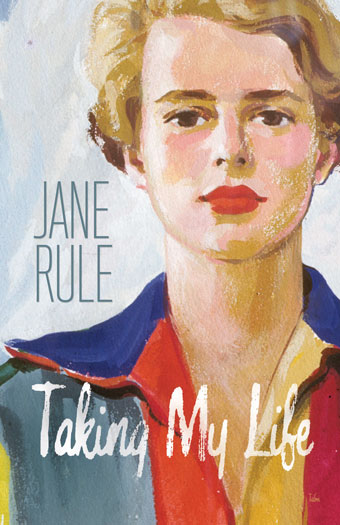
Taking My Life is Jane Rule’s autobiography, yet it was only published posthumously in October 2011. And it might never have been published, had it not been found by chance by Linda M. Morra, a Canadian academic, in an archive box at the University of British Columbia a year after Rule’s death. Since both a manuscript and a typescript existed, Morra concluded that Taking My Life was intended for publication and proceeded to edit what she had found.
Jane Rule (1931-2007) is probably one of the most significant lesbian writers of the twentieth century and one for whom I have always had a special fondness. In fact her groundbreaking novel Desert of the Heart (1964) is the first lesbian book I read in the early 1980s when I was trying to work out who I was. I fell in love with it and have read it again several times over the years, but I knew next to nothing about Rule as a person, and even less about the child and teenager she had been.
Taking My Life is about growing up in the USA in the 1930s and 1940s–the book covers Rule’s first 21 years of her life–in an impoverished middle-class household, sandwiched between a wild brother and a much younger sister. Her father was a salesman who was often away for work, and thus the children were mainly brought up by their stay-at-home mother, with formidable grandparents in the background. Rule relates family life in detail and she describes the numerous moves in hope of better prospects and how insecure they made her feel.
Taking My Life is about meeting a string of women who were able to see through the clumsy defiant child and adolescent and encouraged her to mature and develop into the honest and strong woman she finally became by believing in her abilities and strengths–Dr. Elizabeth Pope, her English professor at Mills College being the most notable of her mentors.
But Taking My Life is mostly about Rule growing up queer at a time when such things were not mentioned, and gradually coming to the realisation that she “had no taste for men, except as friends”. It is about falling in love with her very married art teacher, Ann Smith, and being in love with her for years. The relationship between young Jane and her older friend is portrayed with frankness: Ann Smith was a complex woman who pressed Rule toward experimenting with men while lending her The Well of Loneliness, approving of same-sex relationships and having a brief fling with her.
‘It wasn’t the first time she’d kissed me on the mouth, but it was the first time I felt the ache in my gut turn to fire. ‘You have to understand,’ she said, holding my face in her hands. ‘We can’t make love. You have to make love first with a man, adjust to that, or you’ll be a lesbian.’
The end of the memoir is devoted to three trips Rule made to England while at Mills. She first went to Europe to attend a course on Shakespeare in Stratford where she met Roussel Sargeant (whom she first saw on a train and) to whom she felt attracted instantly. The attraction was reciprocal, despite the ten year difference, and a relationship developed. When Rule went back home, they kept in touch. The following summer she crossed the Atlantic to be reunited with Roussel and visit Europe. Although the trip was not as satisfactory as Rule had hoped, she still planned to spend a year in London where she could live with her English lover. The plan materialised and thanks to Rule’s family she was able to finance the year and learn to “live with the baggage of (her) life, its rhythms of failure and rebirth”.
I was expecting to enjoy Taking My Life and was not disappointed. It is an engaging memoir which portrays a detailed side of Jane Rule we do not necessarily perceive in her novels and essays. It is an absorbing and fascinating read and will hopefully rekindle interest in her writings.

Excellent review. That would be a fascinating book to read; to gain some insight into the powerful woman Jane Rule became. Hope it gets good exposure on various GLBT sites.
Great review! I think I’m going to have to bump up this book in my to-review list. Jane Rule was such an amazing trailblazer.